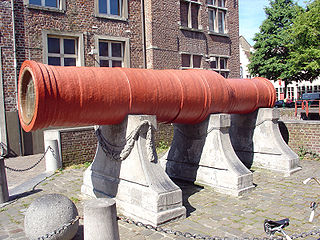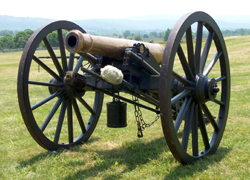
A cannon is a large-caliber gun classified as a type of artillery, which usually launches a projectile using explosive chemical propellant. Gunpowder was the primary propellant before the invention of smokeless powder during the late 19th century. Cannons vary in gauge, effective range, mobility, rate of fire, angle of fire and firepower; different forms of cannon combine and balance these attributes in varying degrees, depending on their intended use on the battlefield. A cannon is a type of heavy artillery weapon.

Liv Grete Skjelbreid from Hålandsdal, Fusa, near the city of Bergen in western Norway, is a former professional biathlete. On 20 March 2006, Liv Grete announced her retirement, effective at the end of the season which ended on 26 March at the Holmenkollen. She said that she was retiring because of her young daughter, Emma, her family and because she did not have the motivation to continue.

The formal definition of large-calibre artillery used by the United Nations Register of Conventional Arms (UNROCA) is "guns, howitzers, artillery pieces, combining the characteristics of a gun, howitzer, mortar, or multiple-launch rocket system, capable of engaging surface targets by delivering primarily indirect fire, with a calibre of 75 millimetres and above". This definition, shared by the Arms Trade Treaty and the Treaty on Conventional Armed Forces in Europe, is derived from a definition in United Nations General Assembly Resolution 46/36L, which set a threshold of 100mm. Several grammatical changes were made to that latter in 1992 and the threshold was lowered in 2003 to yield the current definition, as endorsed by UN General Assembly Resolution 58/54.

A ranged weapon is any weapon that can engage targets beyond hand-to-hand distance, i.e. at distances greater than the physical reach of the user holding the weapon itself. The act of using such a weapon is also known as shooting. It is sometimes also called projectile weapon or missile weapon because it typically works by launching solid projectiles ("missiles"), though technically a fluid-projector and a directed-energy weapon are also ranged weapons. In contrast, a weapon intended to be used in hand-to-hand combat is called a melee weapon.

Naval artillery is artillery mounted on a warship, originally used only for naval warfare and then subsequently used for shore bombardment and anti-aircraft roles. The term generally refers to tube-launched projectile-firing weapons and excludes self-propelled projectiles such as torpedoes, rockets, and missiles and those simply dropped overboard such as depth charges and naval mines.

Mons Meg is a medieval bombard in the collection of the Royal Armouries, on loan to Historic Scotland and located at Edinburgh Castle in Scotland. It has a barrel diameter of 20 inches (510 mm) making it one of the largest cannons in the world by calibre.

The bombard is a type of cannon or mortar which was used throughout the Middle Ages and the early modern period. Bombards were mainly large calibre, muzzle-loading artillery pieces used during sieges to shoot round stone projectiles at the walls of enemy fortifications, enabling troops to break in. Most bombards were made of iron and used gunpowder to launch the projectiles. There are many examples of bombards, including Mons Meg, the Dardanelles Gun, and the handheld bombard.

The Basillica or Great Turkish Bombard is a 15th-century siege cannon, specifically a super-sized bombard, which saw action in the 1807 Dardanelles operation. It was built in 1464 by Ottoman military engineer Munir Ali and modelled after the Orban bombard that was used for the Ottoman besiegers of Constantinople in 1453.

The Dulle Griet is a medieval large-calibre gun founded in Gent (Ghent).

Orban, also known as Urban, was an iron founder and engineer from Brassó, Transylvania, in the Kingdom of Hungary, who cast large-calibre artillery for the Ottoman siege of Constantinople in 1453.

Military forces of the Ottoman Empire used a variety of weapons throughout the centuries. The armoury in Topkapı Palace has a large collection of which it shows select items.

The Faule Mette or Faule Metze was a medieval large-calibre cannon of the city of Brunswick, Germany.

The Pumhart von Steyr is a medieval large-calibre cannon from Styria, Austria, and the largest known wrought-iron bombard by caliber. It weighs around 8 tons and has a length of more than 2.5 meters. It was produced in the early 15th century and could fire, according to modern calculations, an 80 cm stone ball weighing 690 kg to a distance of roughly 600 m after being loaded with 15 kg of gunpowder and set at an elevation of 10°.
The Grose Bochse was a medieval large-calibre cannon of the Teutonic Order. It was cast from June to September 1408 in several pieces and was presumably assembled by a screw or plug connection. The cannon was even bigger than the slightly later finished Faule Grete and may have reached the dimensions of the largest known bombard by caliber, the Pumhart von Steyr.

The Rikugun Ki-93 was a prototype Japanese twin-engined fighter aircraft of the Second World War. Designed by the Army Aerotechnical Research Institute, to be a heavy fighter armed with large calibre cannon to serve in the anti-shipping or bomber destroyer roles, only one example of the Ki-93 was completed; this was damaged on its maiden flight, and destroyed by American bombing before it could be flown again.

The Calibres de France was a system of standardization of cannons in France, established by King Francis I of France from about 1525. The objective was to simplify and codify cannonry, in order to facilitate production. On 26 September 1526, Francis I wrote about the artillerye de mon calibre, and an even earlier mention is known from 1512. The Calibres de France were formalized in an ordinance of 1552.
This is a timeline of the history of gunpowder and related topics such as weapons, warfare, and industrial applications. The timeline covers the history of gunpowder from the first hints of its origin as a Taoist alchemical product in China until its replacement by smokeless powder in the late 19th century.

The M1841 6-pounder field gun was a bronze smoothbore muzzle-loading cannon that was adopted by the United States Army in 1841 and used from the Mexican–American War to the American Civil War. It fired a 6.1 lb (2.8 kg) round shot up to a distance of 1,523 yd (1,393 m) at 5° elevation. It could also fire canister shot and spherical case shot. The cannon proved very effective when employed by light artillery units during the Mexican–American War. The cannon was used during the early years of the American Civil War, but it was soon outclassed by newer field guns such as the 12-pounder Napoleon. In the US Army, the 6-pounders were replaced as soon as more modern weapons became available and none were manufactured after 1862. However, the Confederate States Army continued to use the cannon for a longer period because the lesser industrial capacity of the South could not produce newer guns as fast as the North.

The Boxted Bombard is a 15th-century cannon from England. The bombard is medium in size for its type, its military use is unknown due to a lack of historical records. For a long time unlocated, the piece was rediscovered for the public at the village of Boxted in the 1970s and is now on display at the artillery collection at Fort Nelson.

















